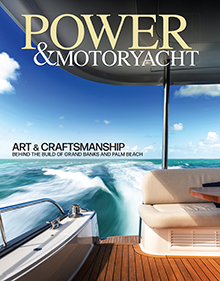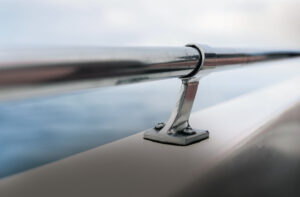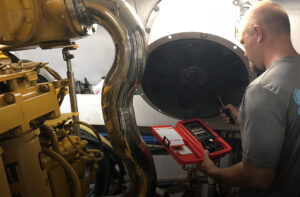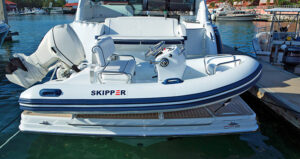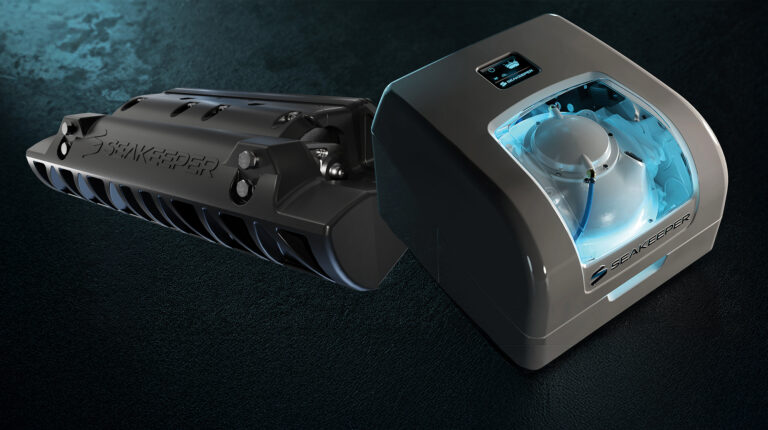Some boats are fine in almost all respects but
harbor a gremlin or two that become annoying out of proportion to their real importance. PMY editor-in-chief Richard Thiel owns such a boat, Ava T., a classic Jarvis Newman 32 ideal for day cruising and overnighting, fishing, or picnicking. Her Cummins diesel is reliable and economical, her equipment simple and dependable, and her performance underway graceful and comfortable. Except for one thing: Devoid of spray rails, Ava T. was as wet as a WWII submarine, showering the pilothouse with salt water under all but the calmest conditions. After several seasons of watching the world through the windshield wipers, Thiel decided that something had to be done about it.
Some round-bilge boats have forward spray rails, to deflect water that would otherwise run up the sides and past the gunwales to blow back onto the crew; Maine lobsterboats, however, usually do not, for some reason known only to Downeasters. (The chines on V-hulls act as spray rails if they run all the way to the stem.) Most boats, including Thiel’s, use spray rails aft, too: At lower speeds water can run up the sides, adding drag and sometimes even curling into the cockpit. Jarvis Newman left forward spray rails off the 32, even though his similar 36 has them fore and aft. It’s an omission many 32 owners regret.
Adding spray rails used to be difficult, involving ship’s carpentry skills and tools most of us lack. But today all you need are Smart-Rails—PVC extrusions that glue onto fiberglass, aluminum, or steel hulls with tenacious structural adhesives. The manufacturer, Smart Marine Products Corporation, packages along with the rails almost everything needed for installation, along with detailed, clearly written instructions. Thiel provided only a caulking gun, some rags, and one jug each of acetone and rubbing alcohol. And an assistant: this writer. The rails are as flexible as cooked spaghetti until glued to the hull, and a second pair of hands is vital to keep them under control.
Smart-Rails come in three styles: The M-1000 mounts on the hull side and is used as a spray rail on both displacement and planing hulls; it can be mounted forward or aft. The M-2000 glues along the chines of planing hulls, usually aft, and (according to the manufacturer) adds lift and improves performance and fuel economy. Both the M-1000 and M-2000 are off-white, but can be painted, and come in nine-foot sections. The M-3000 is a wider version of the M-2000 (three inches rather than 11/2 inches), comes in eight-foot sections, and is black; since M-3000 rails are usually attached below the waterline, color isn’t a problem. They are painted with antifouling like the rest of the bottom.
Thiel ordered a set of M-1000 Smart-Rails that would adhere nicely to Ava T.’s smooth forward sections. The rails are roughly T-shape, with the upright leg thicker than the cross leg and curved into a shallow comma shape. The cross leg glues to the hull with the curve of the comma facing down. On a boat like Ava T., with a top speed of less than 30 knots, the Smart-Rails can be adhered directly onto clean, dewaxed gelcoat, so our first job was to wipe down the area where the rails would go, using plenty of acetone and lots of rags, followed with an alcohol rinse. Faster boats, or those whose gelcoat is in poor condition, should have the gelcoat removed and the underlying laminate primed with resin; the Smart-Rails are then bonded directly to the laminate, after it’s been wet-sanded smooth. Sounds like a lot of work to me, and maybe a job for the yard.
This article originally appeared in the November 2006 issue of Power & Motoryacht magazine.

